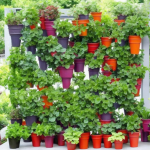With the world becoming more environmentally conscious, landscaping design has risen to the task of merging aesthetic appeal with sustainability. The challenge here is to create a beautiful outdoor space for your home, while conserving water and energy. This article will guide you on how to design your home exterior with drought-resistant landscaping and water conservation features. We’ll delve into the elements of using less water with plants, integrating sustainable energy and lighting, creating a yard that is both visually appealing and environmentally friendly, and much more.
Building a Drought-Tolerant Landscape
When it comes to landscaping, the days of lush green lawns being the yardstick (pun intended) for beauty are long gone. In light of climate change, water scarcity, and energy efficiency, homeowners are shifting towards more sustainable practices. Drought-tolerant landscaping involves the use of plants and trees that can survive with less water and are native to your region.
Also to see : What Are the Key Features of an Eco-Friendly Bathroom with Low-Flow Fixtures and Natural Materials?
Creating a landscape that is drought-tolerant doesn’t mean that your yard will be void of greenery or look arid. In fact, with the right design and plant selection, it can look as attractive as a traditional landscape, if not more. The key to this is using local native plants and trees. They are adapted to the climate and soil of your region, and therefore require less water and maintenance.
Smart Irrigation Practices
A well-designed landscape is nothing without a smart irrigation system. Water is a valuable resource that needs careful management, especially in regions prone to drought. When designing your landscape, consider incorporating systems that conserve water.
Also read : How to Design a Home Library with a Hidden Door for a Secret Retreat?
Drip irrigation, for instance, delivers water directly to the roots of the plants, reducing evaporation and wastage. This method is more efficient than traditional sprinkler systems that lose a significant amount of water to wind and evaporation.
You could also consider rainwater harvesting, where water from roofs and other surfaces is collected, stored, and used for irrigation. This not only conserves water but reduces your water bill as well.
Energy-Efficient Outdoor Lighting
Outdoor lighting can set the mood for your outdoor space, illuminating your landscaping design, and adding an element of safety. However, traditional outdoor lighting can consume a lot of energy and contribute to light pollution. The solution? Opt for energy-efficient lighting options.
LEDs and solar-powered lights are excellent alternatives to traditional outdoor lighting. They consume less energy and last longer, offering savings on your energy bills. Solar-powered lights, in particular, harness the sun’s energy during the day and light up your landscape at night, making them a sustainable and energy-efficient choice.
Sustainable Grass Alternatives
A lush, green lawn is a dream for many homeowners. However, maintaining such a lawn can require a lot of water and energy. There are several alternatives to traditional grass that are not only low in maintenance but are also more environmentally friendly.
One such option is to use native grasses that are adapted to your local climate and can tolerate drought conditions. These grasses require less water and care, yet can provide the same aesthetic appeal. Another option is to use ground cover plants that can provide a carpet of green and often require less water than traditional grass.
The Role of Trees in a Drought-Resistant Landscape
Trees play a crucial role in a drought-resistant landscape. Apart from providing shade and reducing water evaporation, they also create habitats for local wildlife, absorb carbon dioxide, and release oxygen into the atmosphere.
Native trees are a great choice for drought-resistant landscaping. They are adapted to local conditions and can often thrive with minimal water and care. When planting trees, consider their mature size and the amount of shade they will provide to your landscape. This can help in reducing water evaporation and cooling your home, which in turn can lead to energy savings.
In the end, designing a home exterior with drought-resistant landscaping and water conservation features is a balance between aesthetics, sustainability, and practicality. It is about creating an outdoor space that is not only visually appealing but also conserves water, reduces energy usage, and contributes to the overall health of the planet.
Incorporating Hardscaping Elements in Your Design
Hardscaping is an integral part of a drought-resistant landscape design that can significantly reduce water usage. It refers to all the non-living elements in a landscape, such as pathways, patios, benches, walls, fences, and more. These elements not only add structure and visual interest to your outdoor space, but they also require no water and minimal maintenance.
For instance, a gravel pathway or a stone patio can add to your front yard’s curb appeal, requiring no water and little upkeep. Such hardscaped areas can provide space for relaxation or outdoor entertainment, enhancing the functionality and usability of your outdoor space.
Another example is using permeable paving – a type of paving that allows water to pass through it. Permeable pavements are excellent for reducing runoff and increasing the amount of water that goes back into the ground. This is a great way to conserve water in your landscape.
Even better, you can combine hardscaping with plantings for a balanced look. Consider planting drought tolerant plants along the pathways or around the patio. These plants can add a touch of greenery without significantly increasing your water usage.
Incorporating hardscapes in your design is an effective way to create an eco-friendly, low maintenance, and visually appealing outdoor space that aligns with the principles of sustainable landscaping.
Designing with Water-Wise Features
Water-wise features can further enhance your drought-resistant landscaping by conserving water effectively. These features are designed to work with nature, capturing and utilizing water wisely, and minimizing water waste.
Rain gardens are one such feature. These are depressed areas in the landscape filled with water-loving plants that capture runoff from roofs, driveways, and other hard surfaces. The water is slowed down, reducing runoff, and giving it a chance to soak into the ground. Rain gardens are not only functional but also add an interesting aesthetic element to your outdoor spaces.
Another water-wise feature is a dry creek bed. These are shallow ditches filled with pebbles, stones, and boulders, designed to channel water away from your home during heavy rains. Dry creek beds can add an interesting visual element to your landscape and are especially useful in areas prone to erosion.
Incorporating water-wise features into your landscape design can save substantial amounts of water over time, making your outdoor space more sustainable.
Conclusion
When it comes to designing a home exterior with drought-resistant landscaping and water conservation features, every choice matters. From the selection of drought tolerant plants and trees, the installation of smart irrigation systems, the inclusion of energy efficient lighting, the use of sustainable grass alternatives and hardscaping elements, to the integration of water-wise features, each detail can make a significant difference in the amount of water and energy your landscape uses.
Not only can this approach save you money by reducing your water and energy bills, but it also contributes to a healthier and more sustainable planet. It’s a win-win situation for you, your front yard, and the environment.
Remember, creating a sustainable and aesthetically pleasing outdoor space doesn’t have to be a daunting task. With careful planning and the right choices, your landscape can flourish with low water and low maintenance requirements, while still maintaining a high level of curb appeal.













